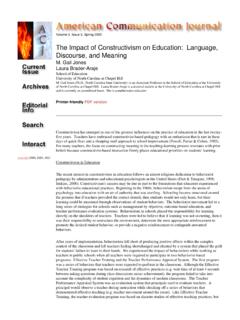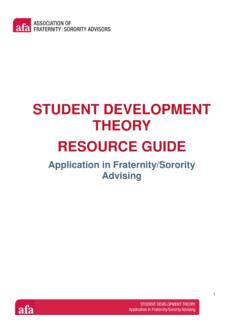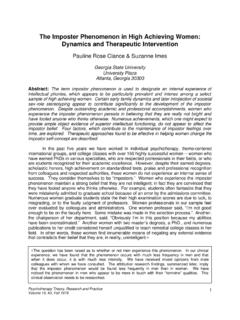Transcription of Media Effects on Body Image: Examining Media Exposure in ...
1 41. American Communication Journal 2012 SPRING (Volume 14, Issue 2). _____. Media Effects on Body Image: Examining Media Exposure in the Broader Context of Internal and Other Social Factors Kristen E. Van Vonderen, University of Central Florida William Kinnally, University of Central Florida ABSTRACT. This study attempts to examine the connection between Media use and body dissatisfaction by juxtaposing the Media with the internalfactor of self-esteem and other social factors such as peer and parental attitudes. A sample of 285 female undergraduates completed measures of Media Exposure , comparisons with Media figures, self-esteem, parental and peer attitudes toward body shape, and peer comparisons, as well as internalization of the thin-ideal and body dissatisfaction measures. Overall, comparison to Media figures was associated with internalization of the thin ideal butnot as strongly as peer attitudes and self-esteem.
2 Contrastingly, peer comparisons and self-esteem were observed to be the strongest indicators of body dissatisfaction. Furthermore,social/environmental influences and self-esteem proved to be the strongest indicators of body dissatisfaction, which suggeststhat the indirect effect of Media messages on body dissatisfaction is an important area for further examination. KEYWORDS: Media Effects , Body Image, Body Dissatisfaction, Cultivation, Social Comparison Contact information: Kristen E. Van Vonderen and William Kinnally, University of Central Florida, Nicholson School of Communication, Box 161344, Orlando, FL 32816-1344, Email: 42. Introduction Thin models and actresses appear to be the standardin today's Media , ever-present on television, and in magazines, movies,and Internet sites. Advertisements targetingyoung women feature thin and beautiful models in desirable circumstances in order to sell clothing, accessories, and other products.
3 There is a mediated normfor body image in present-day culture, and it is characterized by bodies that are extremely thin (Hendriks&Burgoon, 2003). This mediated thin-ideal is present in mainstream Media , and mainstream Media are a source women turn to for information about how to look (Hendriks, 2002). Consequently, women who are heavy viewers of thin-ideal Media may develop the attitude that thinness is socially desirable, experience greater body dissatisfaction, and engage in weight loss behaviors and cosmetic surgery in an attempt to measure up to the standard they observe (Hesse-Biber, Leavy, Quinn, &Zoino, 2006). Additionally, there exists a weight prejudice in our society that is reinforced not only by Media , but also by social interactions with peers and parents (Triplett, 2007). Thinness often has a very positive connotation, one that denotes success and social desirability (Hesse-Biber, Leavy, Quinn, &Zoino, 2006).
4 Attractive people achieve more in our society; they are viewed as more successfuland happier with their lives (Hendriks&Burgoon, 2003). Therefore, some women may see their body shape and weight as a sort of measuring stick of social value (Hesse-Biber, Leavy, Quinn, &Zoino, 2006). In the last few decades,cultivation and social comparisontheories have been used to understandattitudes toward thinness as well as body dissatisfaction in women . Frequently, the associations between Media and body attitudes and satisfaction are examined in relative isolation ( without much consideration of other social influences). Given that Media aren't the only sources of information regarding body shape and appearance,this studyexamines how Media Exposure and Media comparisons are related tointernalization of the thin ideal and body dissatisfaction when considered along withother social sources of attitudes toward body image ( parents and peers), as well as the internal factor of self-esteem.
5 Literature Review Female Body Image in Mass Media Park (2005) noted that the body size of women portrayed in mass Media has been steadily getting , Gray, Mosimann, and Ahrens (1992) studied portrayals of female beauty icons from 1959-1978 and observed that over half of them met the medical criteria for the eating disorder anorexia nervosa. In a follow up study, they observed the same patterns from 1979-1988. (Wiseman, Gray, Mosimann, & Ahrens,1992). There are particular messages associated with body weight in Media ; Media figures are often viewed as the epitome of success and social desirability. Their body weight and beauty are often associated with their success, while overweight actresses and models are frequently ridiculed in Media . This is especially apparent in thin-ideal Media (Harrison, 2000). The phrase thin-ideal Media refers to Media that contain noticeably thin female main characters, such as fitness and 43.
6 Fashion magazines and television programs. Thin-ideal Media promote the idea that thinness is an advantageous attribute and ascribe the attribute to the most beautiful, desirable, and successful protagonists (Harrison, 2000, p. 121). Hendriks and Burgoon (2003) observed that women who are exposed to heavy amounts of thin- ideal mediaare likely to accept this as a (2004) posited that dissatisfaction arises when heavy viewers begin to see this thin-ideal not only as realistic, but also physically attainable. If women who accept these body shapes as the norm and judge themselves in relation to those images, body dissatisfaction can occur (Schooler,et al., 2004). Thus, cultivation and social comparison theories should be considered when researching Media Effects on body image attitudes because heavy viewing may promote internalization of the thin ideal, as well as provide women with Media figures that could be usedas modelsof body shape and beauty.
7 Cultivation Theory George Gerbner (1998) defined cultivation as the independent contributions television viewing makes to viewer conceptions of social reality (p. 180). Cultivation suggests that Media Effects build over time through frequent, repetitive viewing. That is, heavy television viewers were more likely to perceive the real world in accordance with what they had viewed on TV (Gerbner, 1998;Morgan & Shanahan, 2010). Heuristic processing and accessibility are key ideas that have been associated with cultivation. Shrum and Bischak (2001) observed that: people often construct their judgments on probability of occurrence on the basis of attributes of the information they retrieve from memory ( ). The phrase heuristic processing suggests thatpeople tend to seek out small amounts of readily accessibleinformation when making quick judgments, rather than systematically searching their memories (Shrum, 2009).
8 Constructs and ideas that are frequently activated become more accessible over time. When considering body image Effects , it is important to consider what Shrum (2009) observed: that cultivation may not always create attitudes, but often serves to reinforce them. The more thin ideal images women observe, the more accessible these images become. Additionally, the positive connotations that are associated with the thin-ideal may become more accessible. Contrastingly, the more negative associations with overweight people that are observed, the more retrievable they may be, augmenting the sense of importance of maintaining a thin body shape. These retrieved associations may serve to enforce social attitudes regarding weight and its social implications , thinness is good, while being overweight is bad. Morgan and Shanahan (2010) also noted that viewers often seek out programming that reflects and reinforces their existing beliefs, thus further strengthening attitudes.
9 Another element of cultivation theory that must be addressed is that of resonance. According to Shrum and Bischak (2001), resonance is the notion that viewers' life experiences affect their perceptions of the viewers' life experiences are similar to the Media content that they are viewing, the Media messages are more likely to have an effect on them. The authors 44. suggest that direct experiences that are corroborated on televisionalso combine in the viewers'. minds, making it more difficult for them to recall whether the notions stemmed from direct or mediated experience. Additionally, the combination of the experiences makes the content more accessible (Shrum&Bischak, 2001). If a viewer directly observes a negative connotation with being overweight and also observes this situation on television, resonance may cause the connotation to be more readily retrieved during judgments regarding weight and shape.
10 Social Comparison Theory Cultivation theory alone does not explain why women develop these attitudes regarding ideal body shape and social desirability. Social comparison theory also offers a useful perspective on how social attitudes regarding weight and internalization of the thin-ideal might be associated with body dissatisfaction. Social comparison theory proposes that people are constantly evaluating themselves, and do so by comparing themselves to others (Festinger,1954). There are two types of comparisons . downward and upward. Downward comparisons occur when people compare themselves to someone else, and find the other person to be lacking. Upward comparisons, however, are when people compare themselves to someone else and find themselves to be lacking. Tiggemann and Slater (2003) suggested that the process of social comparison may provide the mechanism by which Exposure to Media images induces negative Effects (p.)








